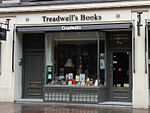Architectural Association School of Architecture
1847 establishments in EnglandArchitectural Association School of ArchitectureArchitecture schools in the United KingdomEducation in the London Borough of CamdenEducational institutions established in 1847 ... and 2 more
Independent schools in LondonProfessional education in London

The Architectural Association School of Architecture in London, commonly referred to as the AA, is the oldest independent school of architecture in the UK and one of the most prestigious and competitive in the world. Its wide-ranging programme of exhibitions, lectures, symposia and publications have given it a central position in global discussions and developments within contemporary architectural culture.
Excerpt from the Wikipedia article Architectural Association School of Architecture (License: CC BY-SA 3.0, Authors, Images).Architectural Association School of Architecture
Bedford Square, London Bloomsbury (London Borough of Camden)
Geographical coordinates (GPS) Address Nearby Places Show on map
Geographical coordinates (GPS)
| Latitude | Longitude |
|---|---|
| N 51.518611111111 ° | E -0.13111111111111 ° |
Address
Bedford Square 31
WC1B 3EG London, Bloomsbury (London Borough of Camden)
England, United Kingdom
Open on Google Maps







